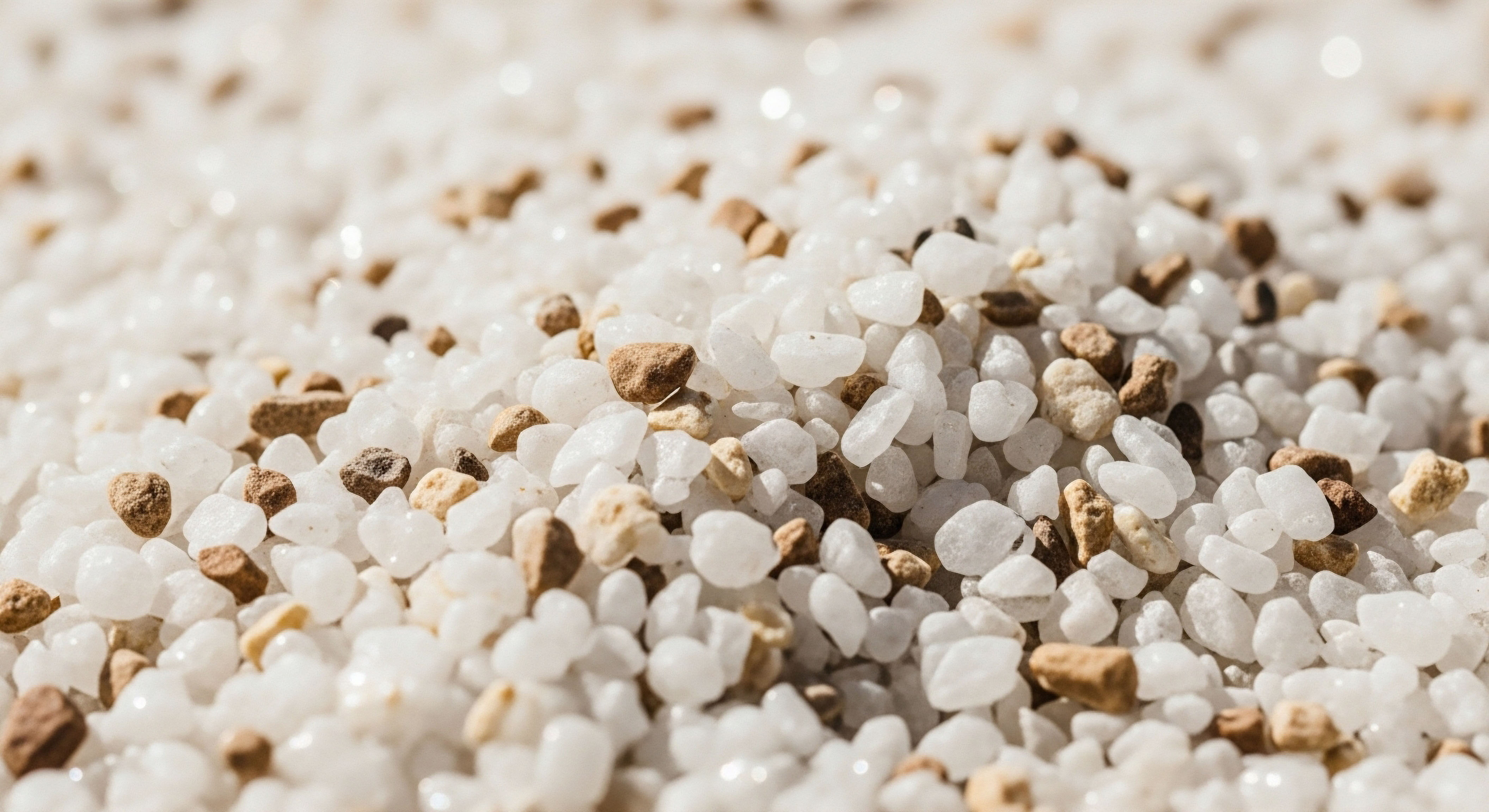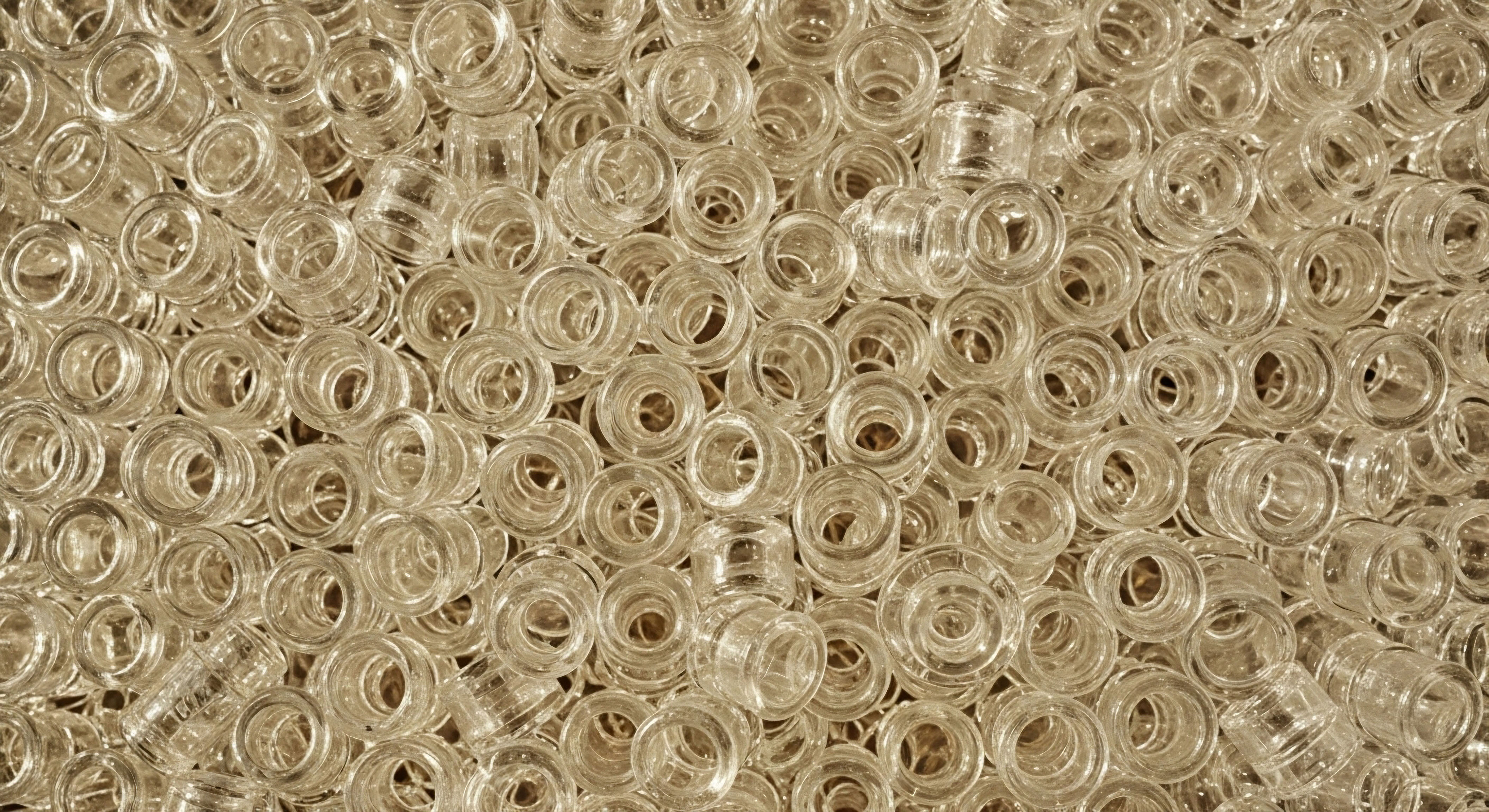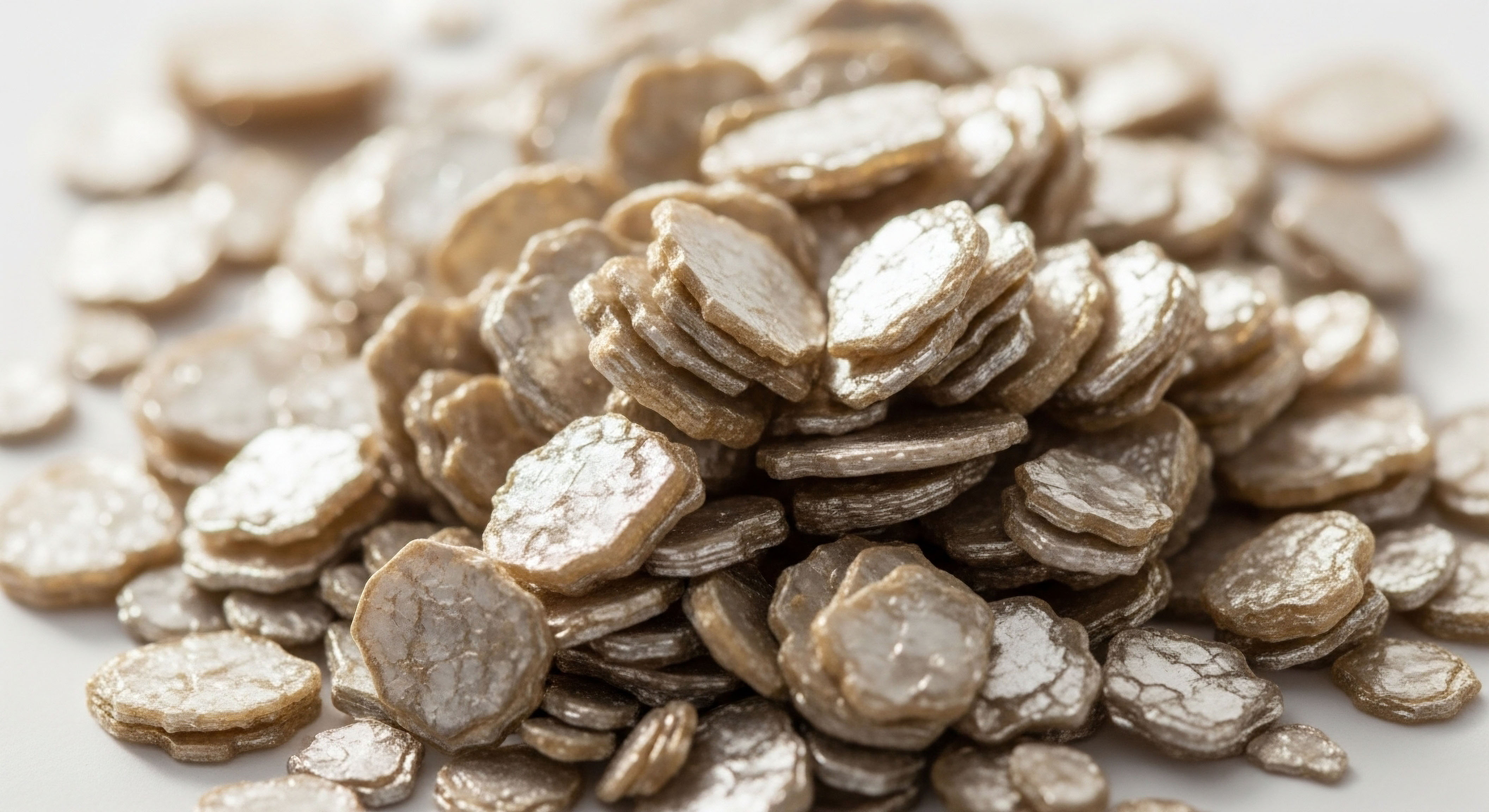

Fundamentals
You feel it in your body ∞ a subtle shift in energy, a change in mood, or a difference in how your physique is responding to your efforts. These experiences are valid, and they often point toward the intricate communication network within your endocrine system.
Your body is constantly sending messages, and one of the most pivotal messengers in this system is the enzyme aromatase. Understanding its function is a foundational step in comprehending your own biological narrative. Aromatase is a protein that facilitates a crucial biochemical conversion, transforming androgens, such as testosterone, into estrogens. This process is a normal and necessary part of human physiology for both men and women, influencing everything from bone density and cognitive function to body fat distribution.
The activity of this enzyme is a dynamic process, influenced by a multitude of factors including age, body composition, and, most importantly, your daily nutritional choices. The foods you consume introduce compounds into your system that can directly interact with and modulate aromatase activity.
This means your diet is an active participant in the dialogue of your hormones. Certain dietary components can naturally temper the rate of this conversion, while others can accelerate it. Recognizing this connection is the first step toward using nutrition as a deliberate tool to support your body’s equilibrium. This is about understanding the system from the inside out, providing your body with the raw materials it needs to function optimally.
Your diet directly communicates with your endocrine system, with specific foods containing compounds that can either slow or speed up the enzyme responsible for estrogen production.
Embarking on a path to hormonal wellness involves becoming aware of these dietary influences. It is a journey of personal science, where you learn to interpret your body’s signals and respond with informed nutritional strategies. The goal is to create a physiological environment that supports vitality and function, and it begins with the choices you make at every meal.
The relationship between your plate and your hormonal state is direct and powerful, offering a tangible way to engage with and support your long-term health.

The Concept of Aromatase Modulation
Modulating aromatase means influencing the speed at which it works. Think of aromatase as a gateway. The number of conversions it allows per second is its “activity level.” Certain foods contain natural compounds that can partially block this gateway, effectively slowing down the conversion of androgens to estrogens.
This is known as aromatase inhibition. Conversely, other dietary and lifestyle factors can open the gateway wider, increasing aromatase activity. This dynamic is central to maintaining hormonal balance. For men, excessive aromatase activity can lead to a relative surplus of estrogen and a deficit of testosterone, contributing to symptoms like increased body fat, fatigue, and reduced libido.
For postmenopausal women, where the primary source of estrogen comes from the aromatization of androgens in peripheral tissues like fat cells, managing aromatase activity is equally important for managing estrogen-dependent conditions. The foods you choose can serve as gentle, daily modulators of this critical enzymatic gateway.

Foods That Influence Aromatase Activity
Your nutritional intake provides a rich source of bioactive compounds that can interact with the aromatase enzyme. A diet rich in specific plant-based foods can provide natural aromatase inhibitors. These foods are not a replacement for clinical therapies but act as a foundational support system for your body’s endocrine health. Understanding which foods to incorporate and which to limit is a practical application of this science.
Here is a look at some dietary components and their general influence on aromatase:
- Cruciferous Vegetables ∞ This family of vegetables, including broccoli, cauliflower, cabbage, and Brussels sprouts, contains compounds like indole-3-carbinol (I3C) and its derivative diindolylmethane (DIM). These molecules support healthy estrogen metabolism.
- Polyphenol-Rich Fruits ∞ Berries, cherries, and pomegranates are packed with polyphenols, a class of compounds that have been shown to have an inhibitory effect on aromatase activity.
- White Button Mushrooms ∞ Studies have shown that extracts from common white button mushrooms (Agaricus bisporus) can inhibit aromatase activity, suggesting their potential role in a hormonally supportive diet.
- Green Tea ∞ The catechins in green tea, particularly epigallocatechin gallate (EGCG), are well-researched polyphenols that may help modulate aromatase.
Conversely, some dietary patterns are associated with increased aromatase activity. High intake of alcohol and processed foods, particularly those rich in sugar and unhealthy fats, can contribute to inflammation and increased adipose tissue, which is a primary site of aromatase expression. Therefore, a whole-foods-based diet is a cornerstone of managing aromatase activity.


Intermediate
Moving beyond the foundational knowledge that diet influences hormonal balance, we can examine the specific biochemical interactions at play. The way dietary components affect aromatase is a direct molecular conversation. The most potent natural aromatase modulators are a class of plant compounds called flavonoids.
These molecules, found abundantly in fruits, vegetables, and teas, have a chemical structure that allows them to bind to the active site of the aromatase enzyme. This is a process of competitive inhibition. Imagine a lock and key ∞ the aromatase enzyme is the lock, and an androgen molecule is the key.
When the key fits the lock, a conversion to estrogen occurs. Flavonoids act like a slightly different key that can fit into the lock but cannot turn it. By occupying the lock, the flavonoid prevents the androgen key from entering, thus slowing down the overall rate of estrogen synthesis.
This mechanism is precisely how certain pharmaceutical aromatase inhibitors, like anastrozole, function. The natural compounds in your diet are operating on the same biological pathway, albeit with a gentler effect. Two of the most studied flavonoids in this context are chrysin and luteolin.
Chrysin, found in passionflower, honey, and mushrooms, has demonstrated a significant ability to inhibit aromatase. Luteolin, present in celery, bell peppers, and carrots, also shows potent inhibitory action. Understanding this competitive inhibition model elevates your perspective from simply eating “good foods” to strategically supplying your body with specific molecules that can perform a desired biochemical task.
Specific plant-based compounds, known as flavonoids, can occupy the active site of the aromatase enzyme, thereby slowing the conversion of testosterone to estrogen through competitive inhibition.

The Role of Micronutrients in Hormonal Regulation
Beyond complex plant compounds, essential micronutrients play a critical and often overlooked role in maintaining hormonal equilibrium. Zinc is a prime example of a mineral that is fundamentally linked to the regulation of aromatase and testosterone production.
Your body requires adequate zinc for the proper functioning of hundreds of enzymatic reactions, including those within the hypothalamic-pituitary-gonadal (HPG) axis, the command center for your reproductive hormones. A deficiency in zinc can have cascading effects. Studies have shown that insufficient zinc levels can lead to a decrease in luteinizing hormone (LH), the pituitary signal that tells the testes to produce testosterone. This directly impacts the supply of androgens available for conversion.
Simultaneously, zinc itself appears to act as a direct inhibitor of the aromatase enzyme. Research indicates that a state of zinc deficiency is associated with increased aromatase activity. In essence, zinc works on two fronts ∞ it supports the production of testosterone and helps prevent its excessive conversion to estrogen.
This dual action makes maintaining adequate zinc status a critical component of any hormonal optimization protocol. Since the body does not store zinc, a consistent daily intake is necessary. Foods rich in bioavailable zinc, such as oysters, red meat, and pumpkin seeds, are vital for this purpose.

Comparative Potency of Dietary Flavonoids
Different flavonoids exhibit varying degrees of aromatase inhibitory potential. Their effectiveness is determined by their unique molecular shape and ability to bind to the enzyme’s active site. The table below compares several well-researched flavonoids and their relative potency, offering a more granular view of how you might structure a diet for hormonal support.
| Flavonoid | Common Dietary Sources | Relative Inhibitory Potency |
|---|---|---|
| Chrysin | Passionflower, Honey, Mushrooms | High |
| Luteolin | Celery, Thyme, Bell Peppers, Carrots | High |
| Apigenin | Parsley, Chamomile, Celery | Moderate |
| Quercetin | Onions, Kale, Apples, Berries | Moderate |
| Genistein | Soybeans, Legumes | Low to Moderate |

Optimizing Zinc Intake for Hormonal Health
Ensuring sufficient zinc intake is a practical step toward supporting healthy testosterone levels and managing aromatase. The bioavailability of zinc, meaning how well your body can absorb and use it, varies depending on the food source. Animal sources generally provide more bioavailable zinc than plant sources, as plants contain compounds called phytates that can bind to zinc and inhibit its absorption. The following table provides a list of zinc-rich foods to help guide your dietary choices.
| Food Source (100g serving) | Approximate Zinc Content (mg) | Notes on Bioavailability |
|---|---|---|
| Oysters (cooked) | ~74 mg | Very High |
| Beef (chuck roast) | ~7 mg | High |
| Pumpkin Seeds | ~7.8 mg | Moderate (contains phytates) |
| Lentils (cooked) | ~1.3 mg | Lower (contains phytates) |
| Spinach (cooked) | ~0.8 mg | Lower (contains phytates and oxalates) |


Academic
A sophisticated understanding of how nutrition influences hormonal pathways requires an examination at the molecular level. The enzyme aromatase is encoded by the CYP19A1 gene. The expression of this gene is tissue-specific and regulated by a complex network of signaling molecules, including hormones and cytokines.
Dietary components can influence not only the catalytic activity of the already-formed enzyme but also the transcription of the CYP19A1 gene itself, effectively controlling how many new enzyme molecules are produced. This dual-level regulation is a key area of research in nutritional endocrinology.
For example, certain polyphenols found in green tea have been observed in laboratory settings to modulate the expression of CYP19A1 isoforms, suggesting a mechanism that goes beyond simple competitive inhibition. This implies that a long-term dietary pattern rich in these compounds could potentially shift the baseline endocrine environment.
The structure-activity relationship of flavonoids is central to their function as natural aromatase inhibitors. The core structure of a flavonoid is a benzopyranone ring system. Specific chemical features on this ring system determine the molecule’s binding affinity for the aromatase active site.
Research has shown that the placement of hydroxyl (-OH) groups and the absence of a sugar molecule (glycosylation) are critical for potent inhibition. For instance, the flavonoid quercetin is often found in plants attached to a sugar molecule (as rutin), which renders it inactive.
When the sugar is cleaved, the resulting quercetin aglycone becomes an active aromatase inhibitor. This level of biochemical detail highlights the importance of food preparation and gut metabolism in liberating these active compounds, transforming our understanding from a simple list of foods to a dynamic system of metabolic activation.

What Is the Interplay between Zinc Status and the HPG Axis?
The influence of zinc on male hormonal health provides a compelling example of systems biology in action. The Hypothalamic-Pituitary-Gonadal (HPG) axis is a tightly regulated feedback loop ∞ the hypothalamus releases Gonadotropin-Releasing Hormone (GnRH), which signals the pituitary to release Luteinizing Hormone (LH), which in turn signals the Leydig cells in the testes to produce testosterone.
Testosterone then signals back to the hypothalamus and pituitary to down-regulate GnRH and LH production, maintaining homeostasis. Zinc deficiency disrupts this axis at multiple points. Animal studies have demonstrated that a lack of zinc impairs LH release from the pituitary, directly reducing the primary stimulus for testosterone synthesis. This creates a state of hypogonadism originating from the central nervous system.
Furthermore, the same research reveals a peripheral effect within the liver, a key site of steroid metabolism. In a zinc-deficient state, the activity of aromatase is significantly increased, while the activity of 5-alpha reductase, the enzyme that converts testosterone to the more potent androgen dihydrotestosterone (DHT), is decreased.
The net result is a systemic shift ∞ less testosterone is produced, and more of what is produced is converted to estradiol, while less is converted to DHT. This biochemical outcome explains the physiological symptoms associated with zinc deficiency and underscores the mineral’s profound role in modulating androgen and estrogen balance.
Clinical data in humans supports these findings, showing that correcting a marginal zinc deficiency in elderly men can significantly increase serum testosterone levels. This body of evidence firmly establishes zinc as a critical modulator of steroidogenesis and hormonal signaling.

Molecular Mechanisms of Flavonoid Action
Delving deeper into the molecular interactions, flavonoids act as competitive inhibitors of aromatase because their phenolic ring structures mimic the A-ring of the androgen substrate. This structural similarity allows them to dock into the enzyme’s active site. The effectiveness of this inhibition is quantified by the inhibition constant (Ki) and the half-maximal inhibitory concentration (IC50).
A lower Ki or IC50 value indicates a more potent inhibitor. For example, the synthetic flavonoid alpha-naphthoflavone (ANF) has a Ki value of 0.2 µM, making it a very potent inhibitor. In comparison, the naturally occurring flavonoid chrysin has a Ki of 2.4 µM, which is comparable to the pharmaceutical drug aminoglutethimide, indicating its significant biological activity. These quantitative measures allow for a precise ranking of the potential impact of different dietary compounds.
- Binding and Inhibition ∞ Flavonoids like chrysin and luteolin competitively bind to the heme iron atom within the active site of the cytochrome P450 aromatase enzyme. This action prevents the enzyme from binding to its natural substrates, androstenedione and testosterone.
- Gene Expression ∞ Beyond direct inhibition, some flavonoids may influence the expression of the CYP19A1 gene. Luteolin, for instance, has been shown to decrease aromatase mRNA and protein levels in certain cell lines, suggesting it can reduce the total amount of the enzyme available.
- Systemic Effects ∞ The cumulative effect of consuming a diet rich in these compounds is a reduction in peripheral estrogen synthesis. This is particularly relevant in the context of age-related hormonal changes and in supporting protocols for conditions where managing estrogen levels is a primary goal.

How Do Dietary Choices Complement Clinical Protocols?
In a clinical setting, individuals on Hormone Replacement Therapy (HRT), particularly Testosterone Replacement Therapy (TRT), are often prescribed pharmaceutical aromatase inhibitors like Anastrozole. The purpose of these medications is to prevent the supraphysiological conversion of administered testosterone into estrogen, thereby mitigating side effects such as gynecomastia and water retention.
A diet strategically designed to manage aromatase activity can be a powerful adjunct to these protocols. By incorporating foods rich in natural aromatase-inhibiting compounds, a patient can support the action of the prescribed medication and potentially achieve hormonal balance with a lower dose of the pharmaceutical agent.
This integrative approach acknowledges that the body is a complex system and that nutrition provides a foundational layer of support for any therapeutic intervention. It is a way of aligning one’s daily habits with their clinical goals, fostering a more stable and resilient endocrine environment.

References
- Om, A. S. & Chung, K. W. (1996). Dietary zinc deficiency alters 5 alpha-reduction and aromatization of testosterone and androgen and estrogen receptors in rat liver. The Journal of Nutrition, 126(4), 842 ∞ 848.
- Monteiro, R. Azevedo, I. & Calhau, C. (2006). Modulation of aromatase activity by diet polyphenolic compounds. Journal of Agricultural and Food Chemistry, 54(10), 3535 ∞ 3540.
- Khan, N. & Mukhtar, H. (2018). Tea polyphenols in promotion of human health. Nutrients, 11(1), 39.
- Campbell, M. J. & Jeng, M. H. (1998). Flavonoid inhibition of aromatase enzyme activity in human preadipocytes. Journal of Steroid Biochemistry and Molecular Biology, 67(3), 255-260.
- Balunas, M. J. & Kinghorn, A. D. (2005). Drug discovery from medicinal plants. Life sciences, 78(5), 431 ∞ 441.
- Prasad, A. S. (1996). Zinc status and serum testosterone levels of healthy adults. Nutrition, 12(5), 344-348.
- Grube, B. J. Eng, E. T. Kao, Y. C. Kwon, A. & Chen, S. (2001). White button mushroom phytochemicals inhibit aromatase activity and breast cancer cell proliferation. The Journal of nutrition, 131(12), 3288 ∞ 3293.
- Fatima, I. et al. (2021). Role of Natural and Synthetic Flavonoids as Potential Aromatase Inhibitors in Breast Cancer ∞ Structure-Activity Relationship Perspective. Anticancer Agents in Medicinal Chemistry, 22(11), 2063-2079.

Reflection
You have now seen the deep connection between the molecules on your plate and the hormonal symphony within your body. The knowledge that specific dietary components can communicate with and modulate a critical enzyme like aromatase is empowering. This is the foundation of personalized wellness.
Your symptoms, your goals, and your unique biology create the context for applying this information. Consider your own daily patterns and nutritional choices. Think about how the foods you consistently consume might be contributing to your body’s current hormonal state. This understanding is the first, most crucial step.
It moves you from a passive recipient of health outcomes to an active participant in your own biological story. The path forward is one of continual learning and self-awareness, where each meal becomes an opportunity to support the vitality you seek.



